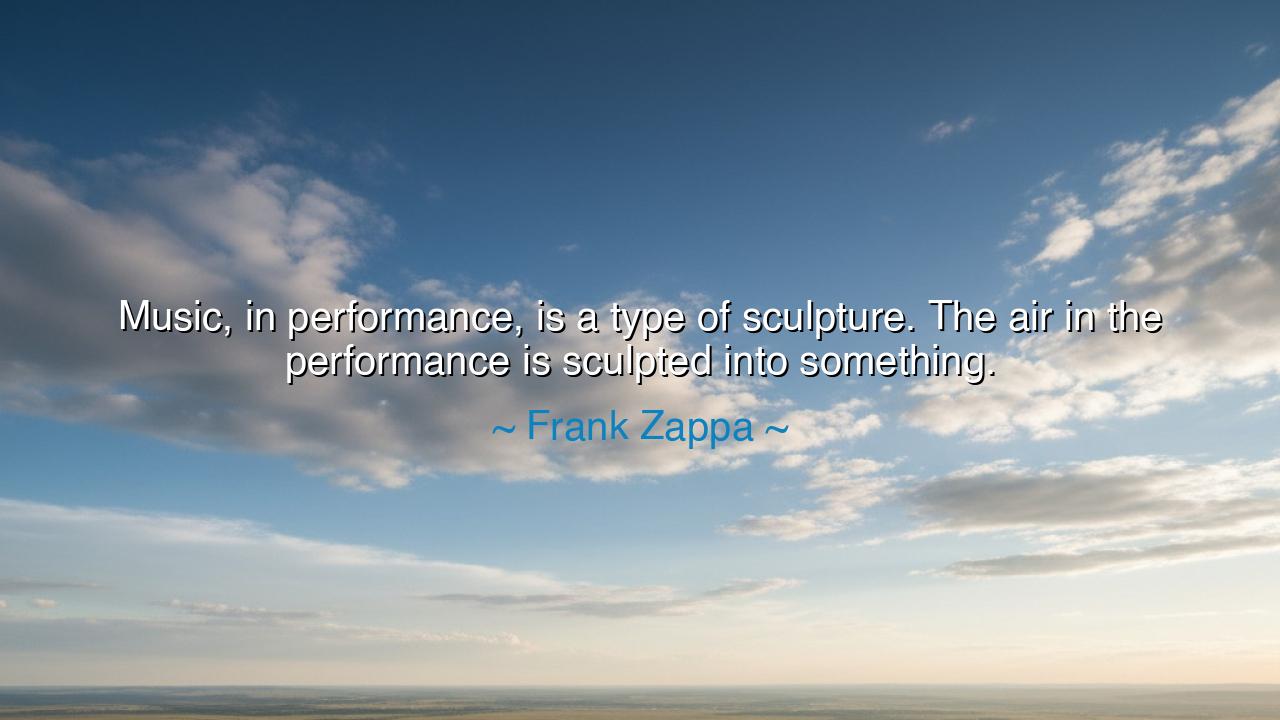
Music, in performance, is a type of sculpture. The air in the
Music, in performance, is a type of sculpture. The air in the performance is sculpted into something.






Hear the words of Frank Zappa, iconoclast and architect of sound, who declared: “Music, in performance, is a type of sculpture. The air in the performance is sculpted into something.” In this vision lies a truth both mystical and profound—that music is not merely notes on a page nor vibrations of strings, but the shaping of the invisible. It is the artist’s hand carving forms out of emptiness, molding the very breath of the world into a shape that the heart can feel though the eyes cannot see.
The first wisdom in this saying lies in the metaphor of sculpture. The sculptor takes raw stone and chisels away, revealing form where before there was only mass. So too does the musician take silence, the formless air itself, and strike it with rhythm, pitch, and tone until it becomes a living structure. In sculpture we behold a figure that endures in marble; in music we behold a figure that endures in memory, carved upon the air for a fleeting moment but immortalized in the soul.
Consider the act of performance. It is not enough to write music, nor even to imagine it; performance breathes life into what was once still. At that moment, musicians become sculptors of time and space. A note struck upon a piano is a hammer against stone; a violin’s bow is the sculptor’s chisel. Each gesture reshapes the silence, turning empty air into architecture of sound, as real to the spirit as cathedrals of stone are to the eyes.
History bears witness to this truth. Think of Ludwig van Beethoven, standing deaf before his orchestra at the premiere of the Ninth Symphony. Though he could not hear with mortal ears, he carved into the air a monument of joy and triumph. Those present felt themselves surrounded by a sculpture not of marble, but of sound—an edifice of exaltation that seemed to rise around them like a temple made of air. The performance was fleeting, yet its structure remains standing in the hearts of mankind to this very day.
The second wisdom is in the fleeting nature of this sculpture of air. Unlike marble or bronze, music dissolves as soon as it is born. The sculpture crumbles back into silence, and yet, in that vanishing, it achieves its magic. For music teaches us that beauty need not endure forever to be real. It may be ephemeral, passing like a breath, but in that moment it reshapes the listener’s soul, leaving an impression more lasting than stone.
The lesson for us is clear: do not despise the intangible. In a world that worships what can be touched and counted, remember that the invisible is often more powerful. Love, joy, sorrow, courage—these cannot be held in the hand, yet they sculpt our lives as surely as the sculptor’s chisel shapes stone. Music reminds us to honor the unseen forces that give meaning to existence, for they are the true architecture of the spirit.
Practical wisdom follows: approach your own life as a kind of sculpture. Each word you speak, each act you perform, is a chisel upon the air, shaping the unseen legacy you leave behind. Like music, your deeds may seem fleeting, but their echoes live on in the hearts of others. Carve carefully, then, with beauty, with intention, with harmony, and you will create something more enduring than monuments—an unseen temple of memory and influence.
Thus remember Frank Zappa’s words: “Music, in performance, is a type of sculpture. The air in the performance is sculpted into something.” Let them remind you that the artist is not only one who shapes stone or paints canvas, but also one who shapes the very breath of existence. Live, then, as both sculptor and musician—molding silence into meaning, fleeting moments into eternal echoes, and empty air into the architecture of the soul.






AAdministratorAdministrator
Welcome, honored guests. Please leave a comment, we will respond soon